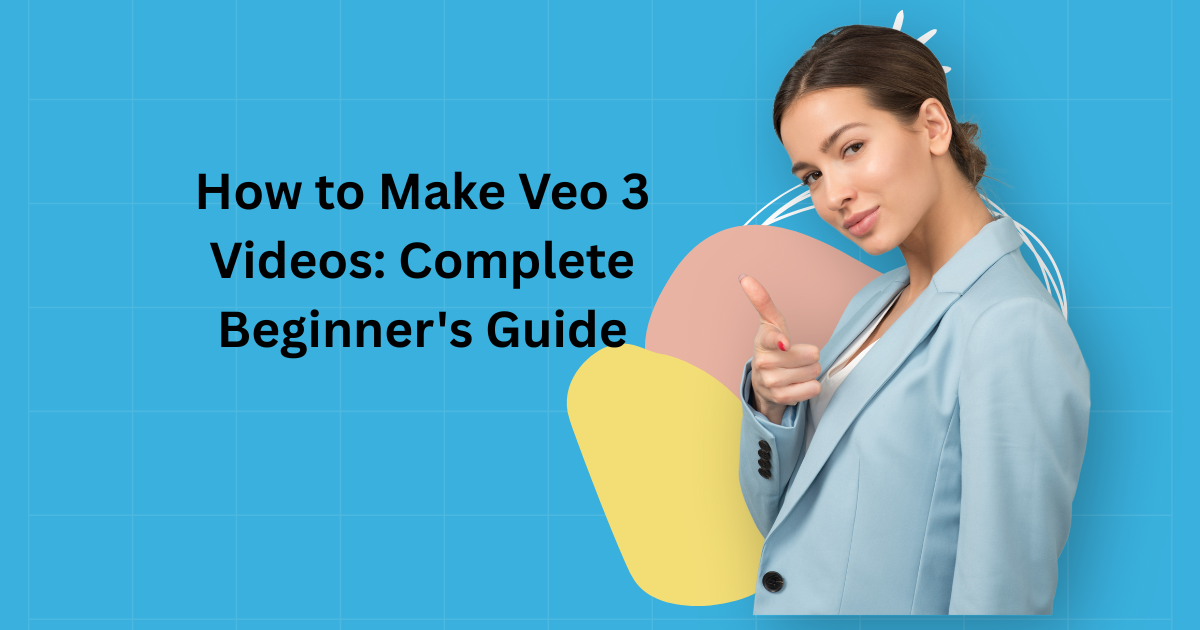Veo 3 is Google’s latest AI video generation model.Whether you’re a content creator, marketer, educator, or business owner, understanding how to leverage Veo 3 can dramatically streamline your video production workflow.
Understanding Veo 3’s Capabilities
Before diving into the creation process, it’s important to understand what makes Veo 3 special. This AI model can generate videos up to several minutes long with improved realism, better motion consistency, and enhanced understanding of complex prompts compared to previous versions. It excels at creating cinematic shots, realistic physics simulations, and maintaining visual coherence throughout longer sequences.
Getting Started: Prerequisites and Access
How to Access Veo 3
Currently, Veo 3 is available through Google’s AI Test Kitchen and selected partner platforms. To get started, you’ll need:
- A Google account
- Access to Google’s AI experimental tools
- Basic understanding of video concepts and terminology
Access may be limited initially as Google gradually rolls out the technology to wider audiences. You can join waitlists through Google’s official AI platforms to receive early access notifications.
Step-by-Step Guide: Creating Your First Veo 3 Video
Step 1: Craft Your Text Prompt
The foundation of any great Veo 3 video is a well-written prompt. Your text description should be:
Specific and Detailed: Instead of “a person walking,” write “a young woman in a red jacket walking confidently down a rain-soaked city street at dusk, neon signs reflecting in puddles.”
Action-Oriented: Include verbs that describe motion and movement. Veo 3 understands dynamic actions better when clearly stated.
Cinematically Aware: Include camera angles, lighting conditions, and mood descriptors. Terms like “wide shot,” “close-up,” “golden hour lighting,” or “dramatic shadows” help guide the visual output.
Contextually Rich: Add environmental details, weather conditions, time of day, and atmospheric elements to create depth.
Step 2: Input Your Prompt into Veo 3
Once you have access to the Veo 3 interface:
- Navigate to the text input field
- Paste or type your carefully crafted prompt
- Review for typos or unclear language
- Adjust any settings available (duration, aspect ratio, style preferences)
Step 3: Generate and Review Initial Output
After submitting your prompt, Veo 3 will process your request. This typically takes several minutes depending on video length and complexity. During generation:
- The system analyzes your text for visual concepts
- AI models render individual frames
- Motion consistency algorithms ensure smooth transitions
- Final compilation creates your video output
Step 4: Refine and Iterate
Your first generation might not be perfect. Here’s how to improve results:
Analyze What Worked: Identify elements that matched your vision and note the specific language you used to achieve them.
Identify Issues: Look for problems like unrealistic physics, inconsistent objects, or unwanted elements in the frame.
Adjust Your Prompt: Modify your text description to address issues. Add more specific details where the output was vague, or simplify overly complex descriptions that confused the model.
Generate Multiple Versions: Create several variations with slightly different prompts to compare results and find the best output.
Advanced Techniques for Better Veo 3 Videos
Using Reference Styles
Mention specific cinematic styles, artistic movements, or visual aesthetics in your prompts. Terms like “film noir aesthetic,” “documentary style,” or “anime-inspired” can dramatically influence the output quality and visual character.
Controlling Camera Movement
Be explicit about camera work. Instead of static descriptions, include phrases like:
- “Camera slowly pans from left to right”
- “Drone shot ascending over the landscape”
- “Steadicam following the subject through the crowd”
- “Time-lapse sequence showing sunset transition”
Mastering Lighting Descriptions
Lighting dramatically affects mood and realism. Incorporate lighting terms such as:
- “Soft diffused natural light”
- “Harsh overhead fluorescent lighting”
- “Backlit silhouette at sunset”
- “Volumetric light rays through fog”
Working with Complex Scenes
For scenes with multiple elements or actions:
- Break down the scene into layers (foreground, middle ground, background)
- Describe each element’s action clearly
- Specify spatial relationships between objects
- Use temporal language for sequenced actions
Common Mistakes to Avoid
Overly Complex Prompts
While detail is good, cramming too many ideas into one prompt can confuse the model. If your description is more than three sentences, consider simplifying or breaking it into multiple videos.
Vague Language
Generic terms like “nice,” “good,” or “beautiful” don’t provide actionable guidance. Replace with specific visual descriptors.
Ignoring Physical Constraints
Veo 3 understands physics better than earlier models, but requesting impossible actions or perspectives can still produce strange results.
Neglecting Aspect Ratio Considerations
Consider your final use case. Square formats work for social media, while widescreen is better for cinematic projects. Specify this in settings or prompts when available.
Practical Applications and Use Cases
Content Marketing
Create engaging social media content, product demonstrations, or explainer videos without expensive production costs.
Education and Training
Develop educational materials, visual demonstrations of concepts, or scenario-based training videos quickly and cost-effectively.
Creative Projects
Experiment with artistic visions, storyboard concepts, or prototype visual ideas before committing to full production.
Business Presentations
Generate compelling visual content for pitch decks, corporate communications, or client presentations.
Quality Optimization Tips
Resolution and Export Settings
When available, always export at the highest resolution offered. While AI-generated content has improved dramatically, higher resolutions provide more detail and professional appearance.
Post-Processing Integration
Consider Veo 3 output as raw material. Combine with:
- Video editing software for cuts and transitions
- Color grading tools for mood enhancement
- Audio editing for sound design and music
- Title and graphic overlays for polish
Consistency Across Multiple Clips
When creating multiple related videos, maintain consistent:
- Lighting descriptions
- Environmental details
- Character or subject descriptions
- Camera style terminology
Understanding Limitations
While Veo 3 represents cutting-edge technology, it has constraints:
Text Rendering: AI models still struggle with legible text within scenes. Avoid prompts requiring readable signs or documents.
Complex Human Interactions: Precise human hand movements or detailed facial expressions may not always render perfectly.
Extended Duration Consistency: Longer videos may show slight inconsistencies in object appearance or environmental details.
Specific Brand or Celebrity Likenesses: For ethical and legal reasons, the model has restrictions on generating specific recognizable individuals.
Best Practices for Professional Results
Plan Your Content Strategy
Before creating videos, outline:
- Purpose and message of each video
- Target audience and their preferences
- Distribution platforms and technical requirements
- How multiple videos connect to tell a larger story
Build a Prompt Library
Document successful prompts and their results. Create a personal database of effective language patterns, descriptions, and techniques that work well with Veo 3.
Stay Updated with Model Improvements
AI video generation evolves rapidly. Follow Google’s official announcements, join user communities, and experiment with new features as they roll out.
Respect Ethical Guidelines
Use Veo 3 responsibly:
- Don’t create misleading or deceptive content
- Respect copyright and intellectual property
- Avoid generating harmful or inappropriate material
- Consider disclosing AI-generated content when appropriate
Troubleshooting Common Issues
Video Doesn’t Match Prompt
Solution: Review your prompt for ambiguous language. Add more specific visual details and eliminate contradictory descriptions.
Poor Quality or Artifacts
Solution: Simplify complex scenes, adjust prompt complexity, or try different phrasings for problematic elements.
Inconsistent Motion
Solution: Be more explicit about movement speed and direction. Use temporal markers like “slowly,” “suddenly,” or “gradually.”
Unwanted Elements Appearing
Solution: Specifically state what should NOT be in the scene, though this works variably. Better to describe desired elements comprehensively.
Future of AI Video Generation
Veo 3 represents just one step in the rapidly evolving landscape of AI video creation. As technology advances, we can expect:
- Longer video durations with maintained quality
- Better understanding of complex narratives
- Enhanced control over specific elements
- Integration with other creative tools and workflows
- Improved realism approaching photographic quality
Conclusion: Maximizing Your Veo 3 Experience
Creating compelling videos with Veo 3 combines technical understanding, creative vision, and iterative refinement. Start with clear, detailed prompts, learn from each generation, and gradually develop expertise in communicating your visual ideas to the AI model.
The key to success lies in experimentation. Generate multiple versions, test different prompt structures, and build your understanding of how language translates to visual output. As you develop this skill, you’ll find Veo 3 becomes an increasingly powerful tool in your creative arsenal.
Remember that AI video generation is a collaborative process between human creativity and machine capability. Your unique vision, combined with Veo 3’s technical prowess, can produce remarkable results that would have been impossible or prohibitively expensive just years ago.
Start experimenting today, and discover how Veo 3 can transform your video creation workflow.

